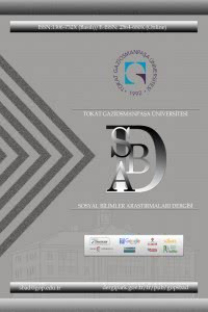“ORTA YOLU YOK MU BU İŞİN?”: EŞLERİN ETKİLEME STRATEJİLERİ ÜZERİNE BİR ARAŞTIRMA
Etkileme Stratejileri, Satın alma karar süreci, Evli çiftler, Konut satın alma
“IS THERE NO MIDDLE WAY?”:A RESEARCH ON COUPLES’ INFLUENCE STRATEGIES
___
- Aygün, İ. ve Kazan, H. (2008), “Aile Üyelerinin Aile Satın Alma Kararlarına Etkileri: İstanbul uygulaması”, Sosyal Ekonomik Araştırmalar Dergisi, 1:15, 227-248.
- Aymankuy, Y. ve Ceylan, U. (2013), “Ailelerin Turistik Ürün Satın Alma Karar Sürecinde Çocukların Rolü (Yerli Turistler Üzerinde Bir Araştırma)”, Elektronik Sosyal Bilimler Dergisi, 45:12, 105-122.
- Bokek-Cohen, Y.A. (2008), “Tell Her She’s Wrong! Triangulation as a Spousal Influence Strategy”, Journal of Consumer Marketing, 25:4, 223-229. Bokek-Cohen, Y.A. ve Lissitsa, S. (2010), Sex: The Power of the Powerless? The Use of Sex as a Spousal Influence Strategy in Vacation Purchase Decisions, Asia Pacific Journal of Tourism Research, 15:4, 431-448.
- Cengiz, E. (2009), “Satın Alma Kararlarında Ailedeki Eşlerin Etkisi ve Bu Etkiyi Şekillendiren Değişkenler”, Atatürk Üniversitesi İktisadi ve İdari Bilimler Dergisi, 23:1.
- Chaudhary, M. ve Gupta, A. (2012), “Exploring the Influence Strategies Used by Children: An Empirical Study in India”, Management Research Review, 35:12, 1153-1169.
- Davis, H. L. (1976), “Decision making within the household”. Journal of Consumer Research, 2:4, 241-260
- Falbo, T. ve Peplau, L. A. (1980), “Power strategies in intimate relationships”. Journal of Personality and Social Psychology, 38, 618–628.
- Filiatrault, P. ve Ritchie, J.B. (1980), Joint purchasing decisions: A Comparison of Influence Structure in Family and Couple Decision-Making Units. Journal of Consumer Research, 7:2, 131-140.
- Hamilton, K. (2009), Consumer Decision Making in Low‐Income Families: The Case of Conflict Avoidance. Journal of Consumer Behaviour, 8:5, 252-267.
- Kelly, R.F. ve Egan, M.B. (1969), Husband and Wife Interaction in a Consumer Decision Process. In Fall International Congress of the American Marketing Association, 250-258.
- Kim, C. ve Lee, H. (1996), “A Taxonomy of Couples Based on Influence Strategies: The Case of Home Purchase”, Journal of Business Research, 36:2, 157-168.
- Kitapcı, O. ve Dörtyol, İ.T. (2009), “Tüketici Satın Alma Karar Sürecinde Aile Bireylerinin Etkileri: Kadının Değişen Rolü Sivas İlinde Bir Uygulama”, Ç.Ü. Sosyal Bilimler Enstitüsü Dergisi, 18:2, 331-348.
- Oh, K. J., Lee, S. ve Park, S. H. (2011), “The Effects of Marital Conflict on Korean Children’s Appraisal of Conflict and Psychological Adjustment”, Journal of Child and Family Studies, 20:4, 444-451.
- Palan, K.M. ve Wilkes, R.E. (1997), “Adolescent-Parent Interaction in Family Decision Making”, Journal of Consumer Research, 24:2, 159-169.
- Rubin, J. Z., Pruitt, D.G. ve Kim, S.H. (2004), Social conflict: Escalation, stalemate, and settlement (3rd edn). McGraw-Hill: New York. Shoham, A. ve Dalakas, V. (2006), “How Our Adolescent Children Influence Us as Parents”, Journal of Consumer Marketing, 23:6, 344–350.
- Spiro, R.L. (1983), “Persuasion in Family Decision-Making”, Journal of Consumer Research, 9:4, 393-402.
- Weigel, D. J., Bennett , K. K. ve Ballard-Reisch, D. S. (2006), Influence Strategies in Marriage: Self and Partner Links Between Equity, Strategy Use, and Marital Satisfaction and Commitment, The Journal of Family Communication, 6:1, 77-95.
- Williams, L.A. ve Burns, A.C. (2000), “Exploring The Dimensionality of Children’s Direct Influence Attempts”, Advances in Consumer Research, 27, 64–71.
- Zvonkovic, A. M., Schmiege, C. J. ve Hall, L.D. (1994), “Influence Strategies Used When Couples Make Work-Family Decisions and Their Importance for Marital Satisfaction”, Family Relations, 43:2, 182-188.
- ISSN: 1306-732X
- Yayın Aralığı: 2
- Başlangıç: 2006
- Yayıncı: Gaziosmanpaşa Üniversitesi Sosyal Bilimler Enstitüsü
1722-23’TE SİVAS EYALETİNDE CEBELÜ BEDELİ UYGULAMASI
İŞLETMELERDE YENİLİK YÖNETİMİ: DÜNYANIN EN YENİLİKÇİ 50 ŞİRKETİ ÜZERİNE BİR ARAŞTIRMA
İŞLETME BÖLÜMÜ ÖĞRENCİLERİNİN YÖNEYLEM DERSİNE YÖNELİK TUTUMLARI
YASEMİN YILDIRIM SAĞLAMCI, EMRE ASLAN
TÜRKÇE ÖĞRETMENİ ADAYLARININ METİN KAVRAMI VE METİNLE TÜRKÇE ÖĞRETİMİ İLE İLGİLİ GÖRÜŞLERİ
20. YÜZYILIN BAŞLARINDA OSMANLI HAPİSHANELERİ: YOZGAT ÖRNEĞİ
TÜRK DİLİ VE EDEBİYATI BÖLÜMÜ ÖĞRENCİLERİNİN KLASİK TÜRK EDEBİYATI DERSLERİNE İLİŞKİN GÖRÜŞLERİ
İŞ YAPMA KOLAYLIĞI KAPSAMINDA MINT ÜLKELERİ ÜZERİNE BİR DEĞERLENDİRME
NALAN KANGAL, İLHAN EROĞLU, MUSTAFA NECATİ ÇOBAN
ORTAOKUL TÜRKÇE DERS KİTAPLARINDAKİ ANLATI METİNLERİNDE METİNLERARASI İLİŞKİLER
